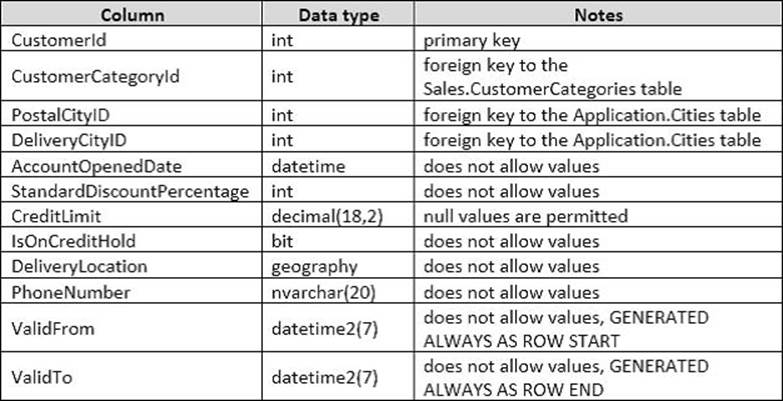How should you complete the Transact-SQL statement?
DRAG DROP
Note: This question is part of a series of questions that use the same scenario. For your convenience, the scenario is repeated in each question. Each question presents a different goal and answer choices, but the text of the scenario is exactly the same in each question in this series.
You have a database that tracks orders and deliveries for customers in North America. System versioning is enabled for all tables. The database contains the Sales.Customers, Application.Cities, and Sales.CustomerCategories tables.
Details for the Sales.Customers table are shown in the following table:

Details for the Application.Cities table are shown in the following table:

Details for the Sales.CustomerCategories table are shown in the following table:

You are preparing a promotional mailing. The mailing must only be sent to customers in good standing that live in medium and large cities. You need to write a query that returns all customers that are not on credit hold who live in cities with a population greater than 10,000.
How should you complete the Transact-SQL statement? To answer, drag the appropriate Transact-SQL segments to the correct locations. Each Transact-SQL segment may be used once, more than once, or not at all. You may need to drag the split bar between panes or scroll to view content.

Answer: 
Explanation:
Box 1: IN (
The IN clause determines whether a specified value matches any value in a subquery or a list.
Syntax: test_expression [ NOT ] IN ( subquery | expression [ ,…n ] )
Where subquery
Is a subquery that has a result set of one column. This column must have the same data type as test_expression.
Box 2: WHERE
Box 3: AND [IsOnCreditHold] = 0
Box 4: )
References: https://msdn.microsoft.com/en-us/library/ms177682.aspx
Latest 70-761 Dumps Valid Version with 212 Q&As
Latest And Valid Q&A | Instant Download | Once Fail, Full Refund

